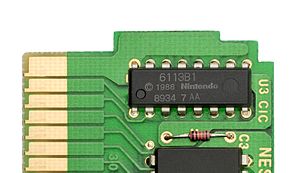
The Checking Integrated Circuit (CIC) is a lockout chip designed by Nintendo for the Nintendo Entertainment System (NES) video game console in 1985; the chip is part of a system known as 10NES, in which a key (which is stored in the game) is used by the lock (stored in the console) to both check if the game is authentic, and if the game is the same region as the console.
The chip was designed in response to the North American video game crash of 1983, which was partially the result of a lack of both publishing and quality control; the idea was that by forcing third-party developers to have their games go through an approval process, Nintendo could stop shovelware from entering the market. Improved designs of the CIC chip were also used in the later Super Nintendo Entertainment System and Nintendo 64, although running an updated security program that performs additional checks.
The lockout chip was controversial, with several developers opting to release their games without Nintendo's approval by using workarounds; the most well-known of these was Tengen (a subsidiary of Atari Games), which copied the CIC chip, resulting in their games running without issue. In response, Nintendo sued Atari for copyright infringement.[1]
- ^ "Atari Games Corp. v. Nintendo of America Inc". h2o.law.harvard.edu. Retrieved 2022-04-14.